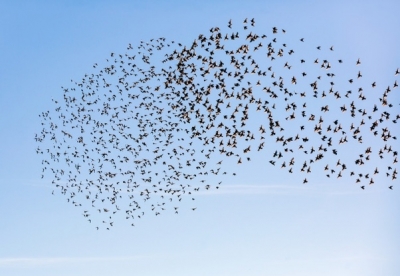
It’s not unusual. A large flock, like you speak of, has the birds touching wingtips all the time. It’s hardly ever with any kind of disastrous results. They just brush up against each other, and then adjust. Or they will feel the turbulence, or simply see the bird next to them, and move over a bit. It’s only for a split second, so you wouldn’t really notice if you’re watching. On the other hand, they are normally not as close to each other as it would seems when you’re watching an enormous flock from a distance. They try to keep clear, but occasionally they will get into each other’s space. Those types of birds can react extremely quickly, and much of it is pure reaction and instinct, without thinking about it.
I have seen owls crash into each other as well. Since they are not as small as flocks of starlings, for instance, they can’t adjust as quickly. The bigger birds crashing usually are a bit more disruptive to their flight.
It’s this instinct that gives you the amazing, fluid, acrobatic formations in the sky. This phenomenon is also seen in fish schools like sardines. It’s believed that they anticipate the move or change in direction. Their field of view is quite large, so they don’t focus on the bird next to them, but rather what’s happening several feet away, many birds away. So by the time they need to change direction, they are able to do so in time. Similar to “the wave” at a football stadium. You see it coming from afar, and by the time it gets to you, you are able to jump up in time to keep it smooth all around the stadium.
Credit : Quora
Picture Credit : Google

